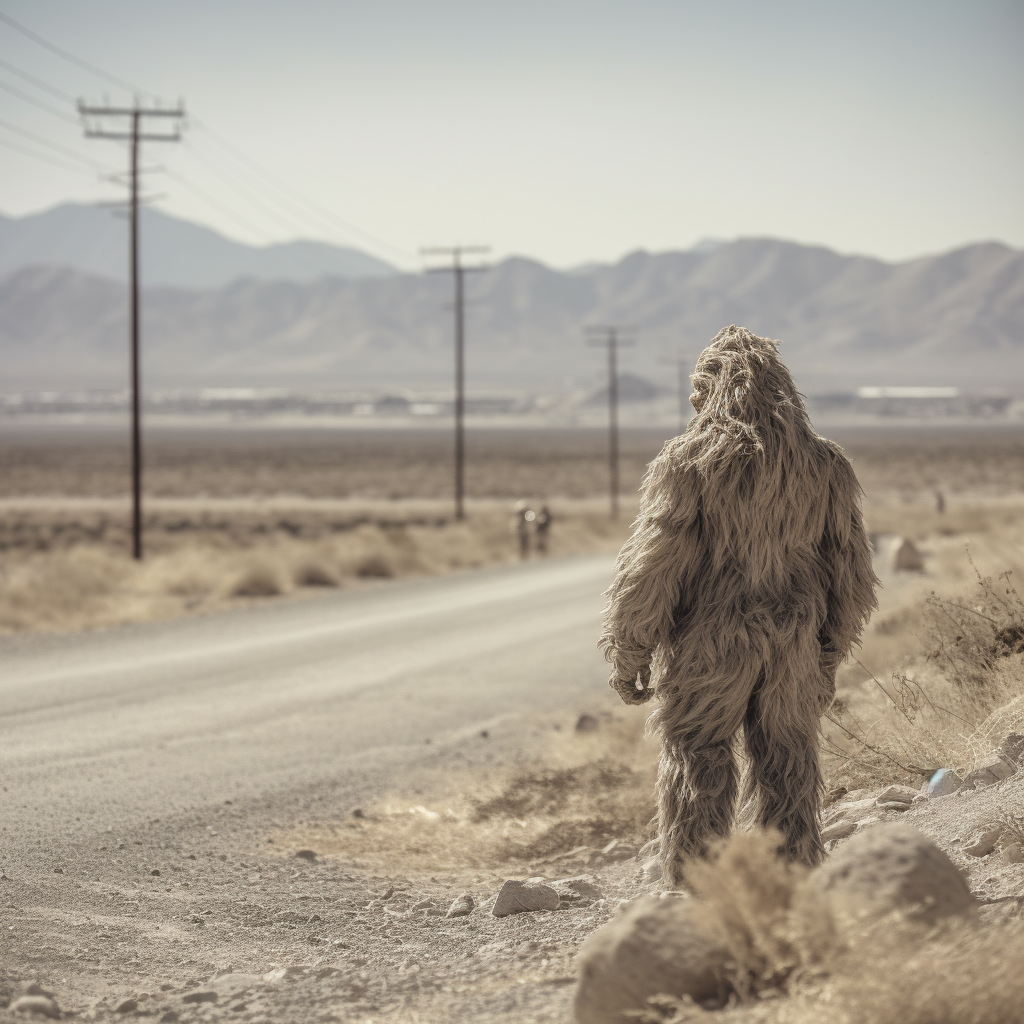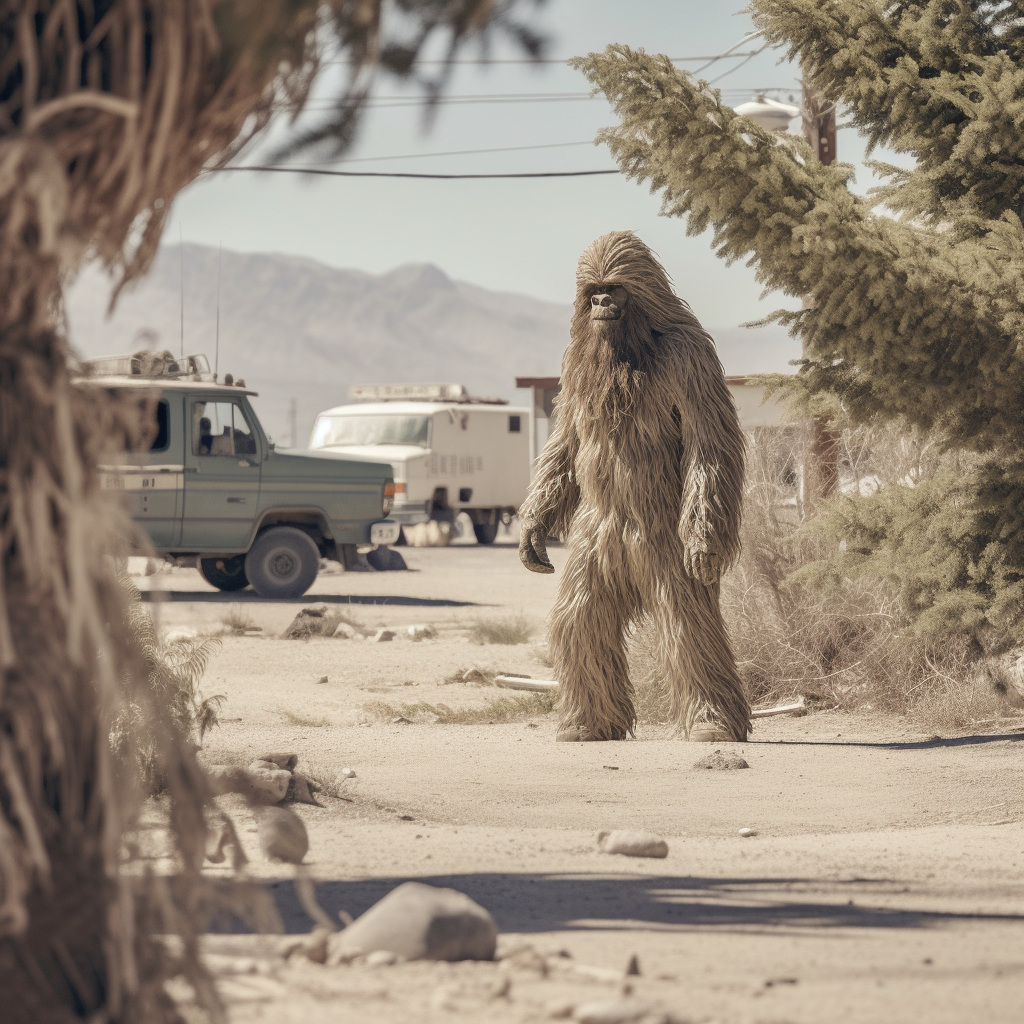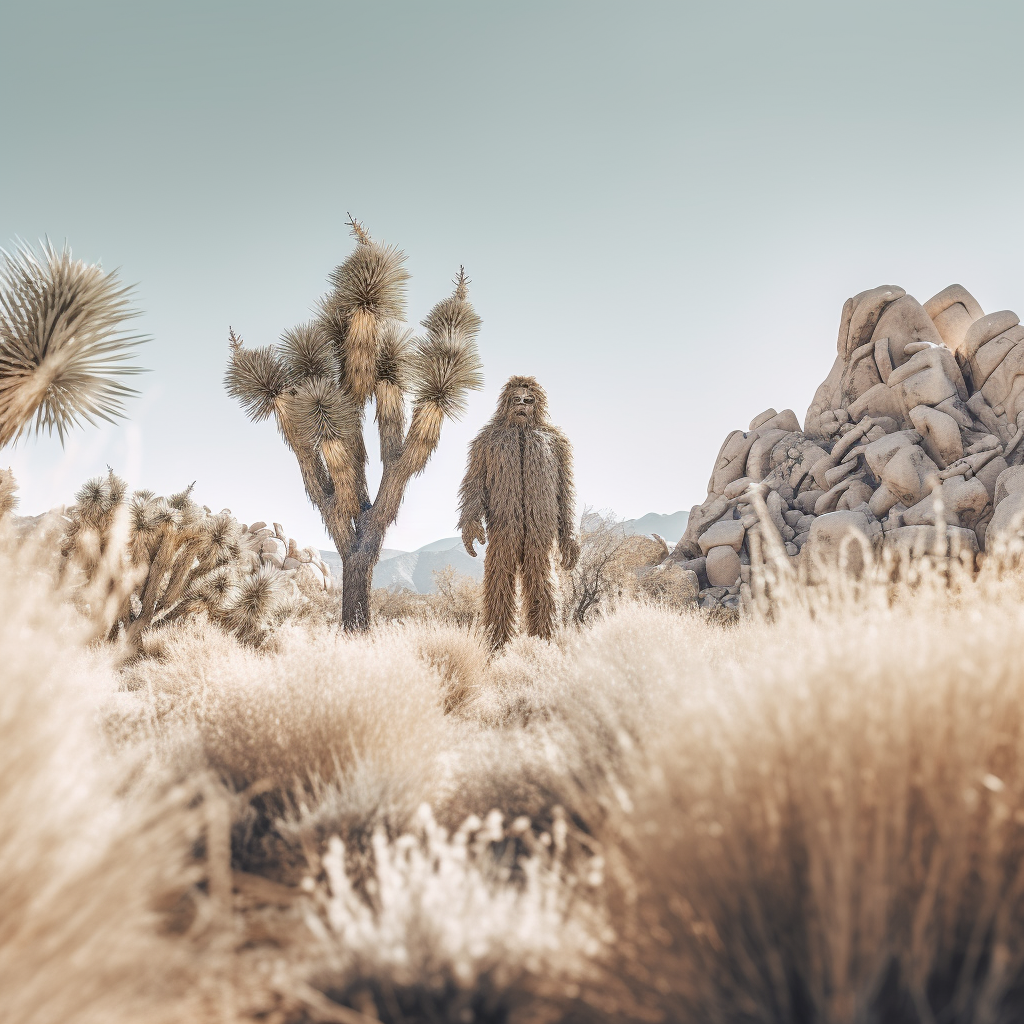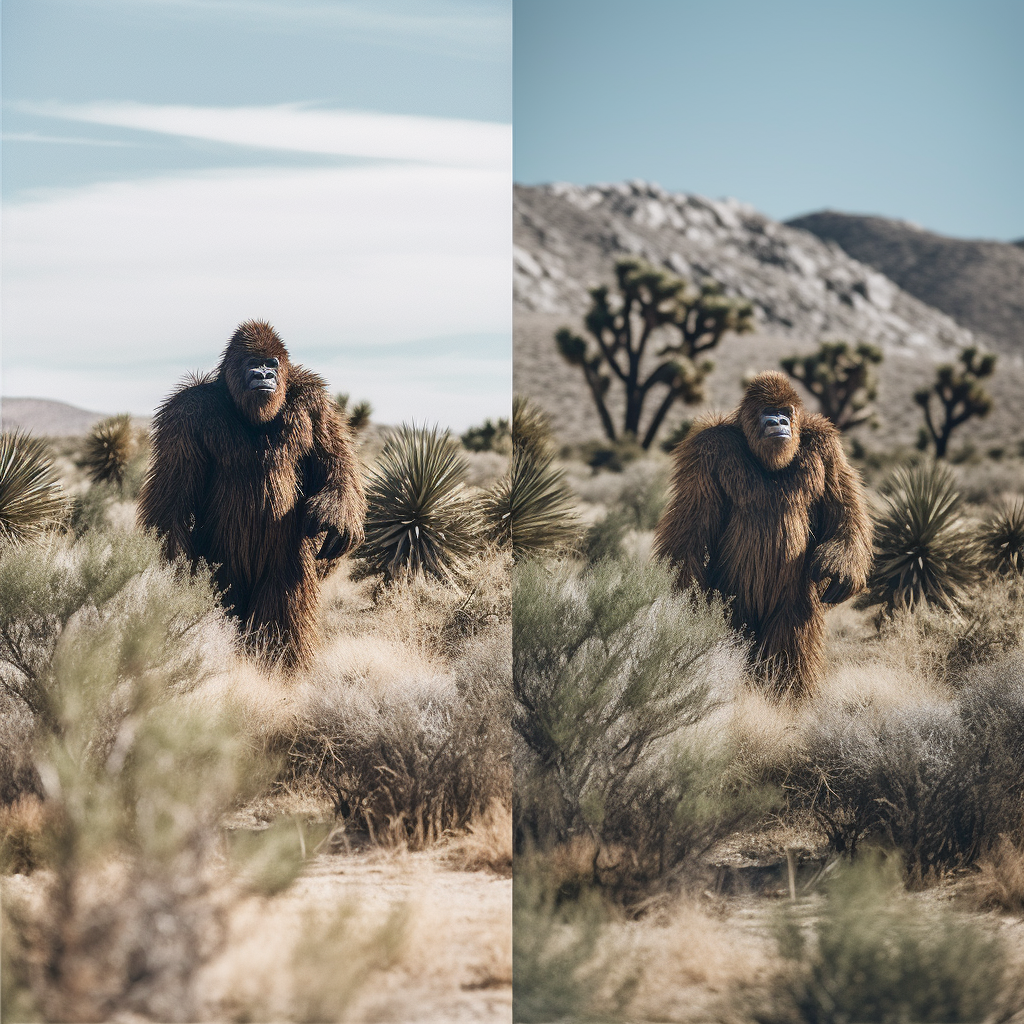Deep within the arid landscapes of Southern California’s Joshua Tree National Park, a mysterious legend has captivated the imagination of many locals and enthusiasts alike. Known as the Yucca Man, this elusive, Bigfoot-like creature has reportedly been spotted on numerous occasions, casting an eerie shadow over the park’s iconic Joshua trees. The enigmatic figure, often described as a colossal, hairy humanoid, is believed to roam the park’s desolate terrain, making the occasional unexpected appearance to the shock of unsuspecting visitors.
The first recorded sighting of the Yucca Man dates back to 1971 when a Marine guarding Twentynine Palms military base encountered the gargantuan being. Startled by the creature’s sudden lunge, the Marine was left barely coherent, with his rifle bent in half, stirring up a wave of speculation about the existence of this cryptid. Despite these claims, the Yucca Man’s true nature remains shrouded in mystery, with some accounts describing shadowy beasts sporting nothing but glowing eyes.

These sightings have led to endless debates among both skeptics and believers, creating an atmosphere of intrigue surrounding the Joshua Tree National Park. As the Yucca Man legend continues to thrive, many curious individuals flock to the desert in hopes of catching a glimpse of this cryptid or unlocking the truth behind its enigmatic presence. With each new account, the line between myth and reality blurs even further, inviting further exploration and speculation on the existence of this elusive creature.
Yucca Man Sightings and Encounters
Joshua Tree National Park
The Yucca Man, a mysterious creature similar to Bigfoot, has been sighted in various locations across Southern California. In Joshua Tree National Park, employees reported sightings of a massive, hairy creature in 1971. The park is home to the unique Joshua Tree (Yucca brevifolia), which is native to the area.
Mojave Desert
In the Mojave Desert, Yucca Man sightings have been reported by residents near the town of Yucca Valley. This desert region is known for its harsh climate, making it a suitable environment for a reclusive creature.
Lucerne Valley
The Lucerne Valley in Southern California has also had alleged encounters with the Yucca Man. While specific details of sightings are scarce, the presence of the creature has become a part of the area’s local folklore.
Desert Hot Springs
In 1979, a couple in Desert Hot Springs claimed that their car journey was interrupted by a massive, hairy creature which they believed to be the Yucca Man. This encounter took place near their condominium.
Big Bear Lake
A sighting in Big Bear Lake occurred in 1988 when two U.S. Marines encountered the creature after a day of snow skiing. They described it as having red eyes and pursued it into a strip mine. One of the Marines, Ken Fox, reported the incident to Sasquatch researcher Douglas E. Trapp.
Twenty-Nine Palms
In the vicinity of Twenty-Nine Palms, California, Yucca Man has allegedly been seen as well. The exact location and details of these sightings have not been widely documented.
Hemet, California
In Hemet, California, two separate sightings took place in 1971, which left evidence behind. A creature, believed to be the Yucca Man, left 17 footprints that were a foot and a half long and six feet apart.
The Yucca Man is often described as huge, scary, aggressive, and fast. The various encounters perpetuate the mysterious legend of this elusive creature in Southern California. While confirmation of its existence is yet to be established, the Yucca Man continues to captivate many with its fascinating, unexplained sightings throughout the region.
Physical Description and Comparison to Other Creatures
Size and Proportions
The Yucca Man is often described as a large, imposing creature, standing taller than the average human. Its size has been the basis for comparison with other well-known cryptid creatures, such as Bigfoot, Yeti, and Sasquatch. While specific height and weight measurements vary across reports, the overall impression is that the Yucca Man is a formidable presence due largely to its size.
Face and Body Features
The face of the Yucca Man has been described as having a primate-like appearance, with features similar to that of an unknown race of prehistoric man. Although specific facial features may differ, the consistent description of a primate-type face distinguishes the Yucca Man from purely human or purely animal descriptions. Body features include thick, long hair covering most of its skin, further linking it to the ape or primate family.
Similarities to Bigfoot
The Yucca Man is often mentioned in the same breath as Bigfoot or Sasquatch due to the following similarities:
- Both are described as large, hairy humanoid creatures
- Both have a primate-like face, suggesting an evolutionary connection
- Both are considered elusive, primarily sighted in remote areas
These shared characteristics have led some to speculate that the Yucca Man and Bigfoot may be part of the same species, or closely related in some way.
Differentiating Factors
While the Yucca Man shares many similarities with other humanoid cryptids like the Bigfoot and the Yeti, there are some distinct factors that set it apart:
- Geographic location: The Yucca Man is primarily associated with the Joshua Tree National Park in the Mojave Desert, while Bigfoot sightings are more common in the Pacific Northwest and the Yeti in the Himalayan region.
- Adaptation to desert environment: The Yucca Man’s survival in the arid desert landscape hints at unique adaptations that may differentiate it from its cold-weather counterparts.
In conclusion, the Yucca Man stands as an intriguing mystery in the realm of cryptids, combining shared features with other infamous humanoid creatures like Bigfoot and Yeti while maintaining its own distinct characteristics.
Joshua Tree and Yucca Species
Yucca Brevifolia
Yucca brevifolia, commonly known as the Joshua tree, is a tree-like species belonging to the yucca genus. It is characterized by its distinctive branching and evergreen foliage. The leaves are white-green and grow in dense clusters at the ends of the branches. Joshua trees are adapted to survive in desert environments, as they can withstand low rainfall and extreme temperature fluctuations.
These trees produce beautiful, large panicles of white flowers. The blossoming process in Joshua trees is highly dependent on the tree’s relationship with the yucca moth.
Yucca Valley
Yucca Valley is a region in the southwestern United States that hosts a high concentration of various yucca species, including the Joshua tree. This area’s unique climate and soil composition provide ideal conditions for the growth of these desert plants.
Cahuilla
The Cahuilla, a Native American tribe of southern California, have a strong connection to Joshua trees and other yucca species in the region. Traditionally, they’ve utilized the tree’s resources – such as fiber from the leaves and food from the fruit – for various purposes. They also recognized the ecological importance of Joshua trees within their territory.
Yucca Moth
The yucca moth plays a crucial role in the lifecycle of the Joshua tree. These moths are responsible for pollinating the flowers, ensuring the tree’s reproduction. Yucca moth larvae feed on the seeds within the flower, and in return, the moths carry pollen from one flower to another, allowing the trees to produce new seeds. This mutualistic relationship has developed over thousands of years, resulting in a delicate ecological balance between the moth and the tree.
Historical and Cultural Background
Mormon Settlers
The history of the Joshua Tree National Park can be traced back to the arrival of Mormon immigrants in the mid-1800s. They named the park after the biblical figure Joshua as the tree’s unique shape reminded them of the biblical story where Joshua reaches his hands up to the sky in prayer. The Mormons followed the Utah Trail and settled in what is now known as the Mojave Desert, where the park is located today.
Urban Legend Origins
The Yucca Man is an urban legend that originated in the California desert, specifically in Joshua Tree, Yucca Valley, and Twentynine Palms. It is often described as a desert-dwelling Bigfoot-like creature and has been a part of local folklore for generations. The first sightings of the Yucca Man date back to the 1970s when a search party in Lancaster, California encountered a large creature they believed to be the mythical beast. Since then, numerous stories and sightings have contributed to the legend’s growth.
Connection to the Military

Joshua Tree’s proximity to military installations such as the Marine base in Twentynine Palms, California has played a role in the Yucca Man’s legend. Some accounts claim that the creature is the result of a secret military experiment gone wrong, while others believe it to be connected to the CIA or FBI covert operations carried out in the region. The military presence and air of secrecy surrounding these operations have helped to fuel the Yucca Man’s mysterious reputation.
The Yucca Man remains a popular subject for those interested in paranormal phenomena and local folklore. While the origins of the urban legend may be rooted in both historical and cultural events, the creature’s existence is yet to be proven. Despite this, the Yucca Man continues to intrigue and captivate the minds of both residents and visitors within the Joshua Tree region.
Investigations and Theories
FBI and CIA Involvement
Though there are no official reports from the FBI or CIA regarding the Yucca Man, its status as an urban legend within the Mojave Desert and in areas surrounding the Joshua Tree National Monument has garnered some attention. It is plausible that these agencies have taken an interest in this phenomenon, given their history of investigating unusual events and possible threats to national security.
Possible Explanations
One possible explanation for sightings of this creature could be the unusual shape of the Joshua trees themselves, which can appear human-like in instances of poor lighting. Additionally, certain animals that inhabit the desert, such as bears, might be mistaken for the Yucca Man due to their size and appearance.
The earliest documented sighting of the Yucca Man dates back to 1971. Since then, there have been numerous reported encounters and sightings in the region, many of which have contributed to the growth of this urban legend. While some witnesses may have genuinely mistaken the sightings for an unknown creature, others might be embellishing their stories or attempting to propagate the legend for various reasons, such as fame or notoriety.
Future Research
To further investigate the origins and credibility of the Yucca Man, there are several avenues for future research:
- Interviewing witnesses: Researchers could compile and analyze firsthand accounts from individuals who have claimed to encounter the Yucca Man to look for patterns or inconsistencies.
- Examining the environment: A thorough examination of the landscape and ecosystem of the Mojave Desert and Joshua Tree National Monument could help in identifying any unusual features or potential explanations for sightings.
- Analyzing historical and cultural contexts: Research into the history and folklore of the region might provide insights into the emergence and persistence of this urban legend.
- Scientific examination: Conducting studies using methods such as DNA testing or footprint analysis could help determine if there is any physical evidence of an undiscovered creature in the area.
Conclusion

In the years since the first reported sighting of the Yucca Man in 1971, this mysterious creature has continued to captivate the imagination of those who hear its tale. Resembling a Bigfoot-like creature, the Yucca Man has been spotted mostly in the vicinity of Joshua Tree National Park, leading some to believe it could be a native species of the area.
While there have been multiple accounts of encounters with the Yucca Man, no concrete evidence has been found to confirm its existence. Some speculate that these sightings could be misinterpretations of known animals or even the result of vivid imaginations. However, the persistence of these stories suggests that the Yucca Man may indeed be more than just a legend.
Researchers and enthusiasts continue to investigate the sightings and gather information in an attempt to determine the true nature of the Yucca Man. Whether it is a previously undiscovered species, a figment of collective imagination, or something else entirely, the intriguing story of the Yucca Man remains an enduring mystery in the Joshua Tree region.
As interest in the Yucca Man continues, future sightings and encounters may provide further insights into this enigmatic creature. For now, the Yucca Man remains a fascinating and elusive character in the colorful tapestry of regional folklore and mythology surrounding the beautiful and otherworldly landscape of Joshua Tree National Park.

